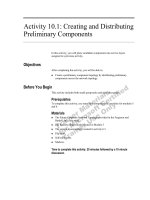Tài liệu Step-by-Step Guide for Creating and Testing Connection Manager Profiles in a Test Lab doc
Bạn đang xem bản rút gọn của tài liệu. Xem và tải ngay bản đầy đủ của tài liệu tại đây (1.69 MB, 59 trang )
Step-by-Step Guide for Creating and Testing Connection
Manager Profiles in a Test Lab
Microsoft Corporation
Published: April 2003
Abstract
This white paper describes how to create and test Connection Manager profiles for connections that use dial-up
over a modem, virtual private networking (VPN) with Point-to-Point Tunneling Protocol (PPTP), VPN with Layer
Two Tunneling Protocol and Internet Protocol Security (L2TP/IPSec), and VPN with Extensible Authentication
Protocol (EAP) in a test lab using five computers. This white paper offers only step-by-step procedures, not a
conceptual overview. It is intended for enterprise-level administrators who have experience managing remote
access connections, administering the Active Directory® directory service, and operating a test lab.
The information contained in this document represents the current view of
Microsoft Corporation on the issues discussed as of the date of
publication. Because Microsoft must respond to changing market
conditions, it should not be interpreted to be a commitment on the part of
Microsoft, and Microsoft cannot guarantee the accuracy of any
information presented after the date of publication.
This White Paper is for informational purposes only. MICROSOFT
MAKES NO WARRANTIES, EXPRESS, IMPLIED OR STATUTORY, AS
TO THE INFORMATION IN THIS DOCUMENT.
Complying with all applicable copyright laws is the responsibility of the
user. Without limiting the rights under copyright, no part of this document
may be reproduced, stored in or introduced into a retrieval system, or
transmitted in any form or by any means (electronic, mechanical,
photocopying, recording, or otherwise), or for any purpose, without the
express written permission of Microsoft Corporation.
Microsoft may have patents, patent applications, trademarks, copyrights,
or other intellectual property rights covering subject matter in this
document. Except as expressly provided in any written license agreement
from Microsoft, the furnishing of this document does not give you any
license to these patents, trademarks, copyrights, or other intellectual
property.
Unless otherwise noted, the example companies, organizations, products,
domain names, e-mail addresses, logos, people, places and events
depicted herein are fictitious, and no association with any real company,
organization, product, domain name, email address, logo, person, place
or event is intended or should be inferred.
© 2003 Microsoft Corporation. All rights reserved.
Microsoft, Active Directory, Windows, and Windows Server are either
registered trademarks or trademarks of Microsoft Corporation in the
United States and/or other countries.
The names of actual companies and products mentioned herein may be
the trademarks of their respective owners.
Contents
Contents 3
Introduction 1
Configuring the Initial Test Lab 2
Configuring and Testing a Dial-Up Profile 9
Configuring and Testing a PPTP Profile 29
Configuring and Testing an L2TP/IPSec Profile 39
Configuring and Testing an EAP Profile 47
Summary 53
Related Links 54
Introduction
This white paper provides detailed information about how you can use five computers to create a test
lab in which you can create and test Connection Manager profiles. These instructions also take you
step-by-step through creating and installing Connection Manager profiles for dial-up remote access,
VPN remote access with PPTP, VPN remote access with L2TP/IPSec, and VPN remote access with
EAP-TLS authentication. As you complete this test lab, you will also test two methods of distributing
profiles to client computers: from a floppy disk and over an intranet connection.
This white paper is intended for enterprise-level administrators who have experience managing remote
access connections, administering Active Directory, and operating a test lab. It does not provide a
conceptual overview of any of the technologies that you implement in the lab or of general test lab
operations. For links to conceptual information, general deployment information, and product details,
see Related Links at the end of this paper.
The instructions in this white paper are cumulative. To reproduce the test lab configurations detailed in
this white paper, you must complete each section in the sequence in which it appears, and you must
follow the steps in each section in sequence.
Note: The following instructions describe configuring a test lab to test the relevant scenarios. To clearly
separate the services provided on the network and to show the desired functionality, you need a minimum
of four servers.
In addition, these test lab configurations reflect neither best practices nor a desired or recommended
configuration for a production environment. For example, the test lab uses the same computer as a domain
controller, a Domain Name System (DNS) server, and a Dynamic Host Configuration Protocol (DHCP)
server. In a production environment, you should not run other services on a domain controller. These test
lab configurations, including IP addresses and all other configuration parameters, are designed to work only
on a test lab network.
Windows Server 2003 White Paper 1
Configuring the Initial Test Lab
To follow the steps in this white paper, you will need to configure five computers in a specific topology.
Each computer in the lab has specific hardware and operating system requirements, which are
specified in the subsections below.
To set up this test lab, you will need the following hardware and software:
• Four computers that are capable of running members of the Windows Server 2003 family
o One server must have two network adapters and a modem.
o One server must have a floppy disk drive.
• One computer that is capable of running Microsoft Windows XP Professional and that has a
modem and a floppy disk drive
• Two network hubs or Layer 2 switches
• One operating system disc for Windows Server 2003, Enterprise Edition
• Three operating system discs for Windows Server 2003, Standard Edition
• One operating system disc for Windows XP Professional
Figure 1 shows the network topology for this lab.
As shown in Figure 1, one segment of the test lab network represents a corporate intranet, and another
segment represents the Internet. Connect all computers on the intranet segment to a common hub or
Layer 2 switch. Connect all computers on the Internet segment to a separate common hub or Layer 2
switch.
Windows Server 2003 White Paper 2
The following subsections describe how you will set up the basic infrastructure. To reconstruct this test
lab, configure the computers in the order presented. Additional sections of this paper describe the
specific configuration steps required for testing dial-up, PPTP, L2TP/IPSec, and EAP-TLS connections.
DC1
As part of setting up the basic infrastructure for the test lab, configure DC1 as the domain controller, the
DNS server, and the DHCP server for a domain that is named example.com.
Perform basic installation and configuration
1. Install Windows Server 2003, Enterprise Edition, and configure the computer as a stand-alone server
named DC1.
2. Configure the connection to the intranet segment with the IP address of 172.16.0.1 and the subnet
mask of 255.255.255.0.
Configure the computer as a domain controller
1. Click Start, click Run, type dcpromo.exe, and click OK to start the Active Directory Installation
Wizard.
2. Follow the instructions in the wizard to create a domain named example.com in a new forest. Install
the DNS service when prompted to do so.
3. Raise the functional level of the example.com domain to a native Windows Server 2003 domain.
Install and configure DHCP
1. Install DHCP as a subcomponent of the Networking Services component.
2. Click Start, point to Administrative Tools, and click DHCP.
3. In the console tree, click dc1.example.com. On the Action menu, and then click Authorize to
authorize the DHCP service.
4. In the console tree, right-click dc1.example.com, and then click New Scope.
5. On the Welcome page of the New Scope Wizard, click Next.
6. On the Scope Name page, type CorpNet in Name, and click Next.
7. On the IP Address Range page, type 172.16.0.10 in Start IP address, type 172.16.0.100 in End IP
address, type 24 in Length, and click Next.
8. On the Add Exclusions page, click Next.
9. On the Lease Duration page, click Next.
10. On the
Configure DHCP Options page, click Yes, I want to configure these options now, and click Next.
11. On the
Router (Default Gateway) page, click Next.
12. On the
Domain Name and DNS Servers page, type example.com in Parent domain. Type 172.16.0.1 in
IP address, click Add, and click Next.
Windows Server 2003 White Paper 3
13. On the WINS
Servers page, click Next.
14. On the
Activate Scope page, click Yes, I want to activate this scope now, and click Next.
15. On the
Completing the New Scope Wizard page, click Finish.
Add computers to the domain
1. Open Active Directory Users and Computers.
2. In the console tree, double-click example.com.
3. Right-click Users, point to New, and then click Computer.
4. In the New Object – Computer dialog box, type IAS1 in Computer name, and click Next.
5. In the Managed dialog box, click Next.
6. In the New Object – Computer dialog box, click Finish.
7. Follow steps 3-6 to create additional computer accounts for IIS1 and VPN1.
IAS1
As part of setting up the basic infrastructure for the test lab, configure IAS1 as the RADIUS server that
provides authentication, authorization, and accounting for VPN1.
Perform basic installation and configuration
1. Install Windows Server 2003, Standard Edition, and configure the computer as a member server
named IAS1 in the example.com domain.
2. Configure the connection to the intranet segment with the IP address of 172.16.0.2, the subnet mask
of 255.255.255.0, and the DNS server IP address of 172.16.0.1.
Install and configure Internet Authentication Service
1. Install Internet Authentication Service as a subcomponent of the Networking Services component.
2. Click Start, point to Administrative Tools, and click Internet Authentication Service.
3. Right-click Internet Authentication Service, and then click Register Server in Active Directory.
When the Register Internet Authentication Server in Active Directory dialog box appears, click
OK. When the Server registered dialog box appears, click OK.
4. In the console tree, right-click RADIUS Clients, and then click New RADIUS Client.
5. On the Name and Address page of the New RADIUS Client wizard, type VPN1 in Friendly name,
type 172.16.0.4 in Client address (IP or DNS), and then click Next.
6. On the Additional Information page, type the same shared secret for VPN1 in both Shared secret
and in Confirm shared secret.
7. Click Finish.
Windows Server 2003 White Paper 4
IIS1
As part of setting up the basic infrastructure for the test lab, configure IIS1 as a Web server and a file
server for the example.com domain.
Perform basic installation and configuration
1. Install Windows Server 2003, Standard Edition, and configure the computer as a member server
named IIS1 in the example.com domain.
2. Configure the connection to the intranet segment with the IP address of 172.16.0.3, the subnet mask
of 255.255.255.0, and the DNS server IP address of 172.16.0.1.
Install and configure IIS
1. Install Internet Information Services (IIS) as a subcomponent of the Application Server component.
2. Create a file in Notepad that contains the text shown in the following figure.
3. Save the file as C:\inetpub\wwwroot\test.html, where C is the drive on which the operating system is
installed.
4. Start Internet Explorer on IAS1. If the Internet Connection Wizard prompts you, configure Internet
access through a LAN connection. In Internet Explorer, type in
Address. You should see the text that you specified in the body of your text file: This is test text.
Configure a shared folder
1. On IIS1, use Windows Explorer to share the root folder of the drive on which you installed the
operating system. Name the share ROOT, and retain the default permissions.
2. To determine whether file sharing is working correctly, on IAS, click Start, click Run, type
\\IIS1\ROOT, and then click OK. You should see the files in the root folder on IIS1.
VPN1
As part of setting up the basic infrastructure for the test lab, configure VPN1 as a remote access server.
VPN1 must have two network adapters and a modem.
Windows Server 2003 White Paper 5
Perform basic installation and configuration
1. Install Windows Server 2003, Standard Edition, and configure the computer as a member server
named VPN1 in the example.com domain.
2. Rename the connection to the intranet segment as CorpNet, and rename the connection to the
Internet segment as Internet.
3. Configure the CorpNet connection with the IP address of 172.16.0.4, the subnet mask of
255.255.255.0, and the DNS server IP address of 172.16.0.1.
4. Configure the Internet connection with the IP address of 10.0.0.2 and the subnet mask of
255.255.255.0.
5. If Windows does not configure the modem automatically, start the Add Hardware wizard, and
configure the modem.
Configure Routing and Remote Access
1. Click Start, point to Administrative Tools, and click Routing and Remote Access.
2. In the console tree, right-click VPN1, and click Configure and Enable Routing and Remote
Access.
3. On the Welcome to the Routing and Remote Access Server Setup Wizard page, click Next.
4. On the Configuration page, Remote access (dial-up or VPN) is selected by default. Click Next.
5. On the Remote Access page, select both the VPN and Dial-up check boxes, and click Next.
6. On the VPN Connection page, click the Internet interface in Network interfaces, and click Next.
7. On the Network Selection page, click the CorpNet interface in Network Interfaces, and click Next.
8. On the IP Address Assignment page, Automatically is selected by default. Click Next.
9. On the Managing Multiple Remote Access Servers page, click Yes, set up this server to work
with a RADIUS server, and click Next.
10. On the
RADIUS Server Selection page, type 172.16.0.2 in Primary RADIUS server, type the shared secret
in Shared secret, and click Next.
11. On the
Completing the Routing and Remote Access Server Setup Wizard page, click Finish.
12. When a message about configuring the DHCP Relay Agent appears, click OK.
Windows Server 2003 White Paper 6
Configure DHCP Relay Agent
1. In the console tree, double-click VPN1, double-click IP Routing, and right-click DHCP Relay Agent,
as shown in the following figure.
2. Click Properties.
3. In the DHCP Relay Agent Properties dialog box, type 172.16.0.1 in Server address, and click Add.
The server address will be added to the list, as shown in the following figure. Click OK.
Windows Server 2003 White Paper 7
CLIENT1
As part of setting up the basic infrastructure for the test lab, configure CLIENT1 as a standalone
computer on a separate network segment. CLIENT1 must have a modem.
1. Install Windows XP Professional, and configure the computer as a standalone computer named
CLIENT1.
2. Configure the connection to the Internet segment with the IP address of 10.0.0.1 and the subnet
mask of 255.255.255.0.
3. If Windows does not configure the modem automatically, start the Add Hardware wizard, and
configure the modem.
Windows Server 2003 White Paper 8
Configuring and Testing a Dial-Up Profile
This section describes how to configure the test lab for dial-up access and phone book distribution,
create a Connection Manager profile for dial-up access, and install and test this profile on the client
computer.
DC1
To configure the test lab for dial-up access, create an appropriate user account and an appropriate
group on DC1.
Create a user account for dial-up connections
1. Open Active Directory Users and Computers.
2. In the console tree under the example.com domain, right-click Users, point to New, and then click
User.
3. In the New Object – User dialog box, type DialUser in First name, type DialUser in User logon
name, and click Next.
4. In the New Object – User dialog box, type a password of your choice in Password and Confirm
password. Clear the User must change password at next logon check box, select the Password
never expires check box, and click Next.
5. In the New Object – User dialog box, click Finish.
Create a group for dial-up connections
1. In the console tree, right-click Users, point to New, and then click Group.
2. In the New Object – Group dialog box, type DialUsers in Group name, and then click OK.
3. In the details pane, double-click DialUsers.
4. In the DialUsers Properties dialog box, click the Members tab, and then click Add.
5. In the Select Users, Contacts, Users, or Groups dialog box, type DialUser in Enter the object
names to select, and click OK.
6. In the Multiple Names Found dialog box, click OK.
7. Click OK to save changes to the DialUsers group.
IAS1
To configure the test lab for dial-up access, configure IAS1 with an appropriate remote access policy for
dial-up access.
Create a remote access policy for dial-up connections
1. Open Internet Authentication Service.
2. In the console tree, right-click Remote Access Policies, and then click New Remote Access
Policy.
Windows Server 2003 White Paper 9
3. On the Welcome to the New Remote Access Policy Wizard page, click Next.
4. On the Policy Configuration Method page, type Dial-up remote access to intranet in Policy
name, and click Next.
5. On the Access Method page, select Dial-up, and click Next.
6. On the User or Group Access page, click Group, and click Add.
7. In the Select Groups dialog box, type DialUsers in Enter the object names to select. Specify the
location as example.com, not IAS1. Click OK. The DialUsers group in the example.com domain is
added to the list of groups on the User or Group Access page. Click Next.
8. On the Authentication Methods page, the MS-CHAP v2 authentication protocol is selected by
default. Click Next.
9. On the Policy Encryption Level page, clear the Basic encryption and Strong encryption check
boxes, and click Next.
10. On the
Completing the New Remote Access Policy Wizard page, click Finish.
IIS1
To configure the test lab for dial-up access, configure IIS1 as a phone book server.
Install Connection Point Services (CPS)
1. Click Start, point to Control Panel, and click Add or Remove Programs.
2. Click Add/Remove Windows Components, click Management and Monitoring Tools, and click
Details.
Windows Server 2003 White Paper 10
3. Select the Connection Point Services check box (as shown in the following figure), and install CPS.
4. When asked whether to enable PBS requests (as shown in the following figure), click Yes.
Configure a user account and permissions for posting phone book data
1. Create a local user account, called Post, for posting phone book data, and clear the User must
change password at next logon check box. Make this account a member of the Guests group. Do
not make this a domain user account.
Windows Server 2003 White Paper 11
2. Open Windows Explorer, double-click Program Files, right-click Phone Book Service, and click
Properties.
3. In the Phone Book Service Properties dialog box, click the Security tab, and click Advanced.
4. Clear the Allow inheritable permissions from the parent to propagate to this object and all
child objects check box. Remove all users from Group or User Names by clicking Remove. Click
OK.
5. Click Add, add the Post user account with Read & Execute and Write permissions, as shown in the
figure below. Click OK.
6. Open Internet Information Services (IIS) Manager.
7. In the console tree, double-click IIS1, double-click FTP Sites, right-click Default FTP Site, and then
click Properties.
8. In the Default FTP Sites Properties dialog box, click the Security Accounts tab, and ensure that
the Allow anonymous connections check box is cleared (as shown in the figure below). If a
warning message appears when you clear the check box, click Yes. Click OK.
Windows Server 2003 White Paper 12
9. In the console tree, double-click Default FTP Site, right-click PBSData, and then click Properties.
10. On the
Virtual Directory tab, select the Write check box (as shown in the figure below).
11. Click OK for
the server to register the changes.
Windows Server 2003 White Paper 13
VPN1
To configure the test lab for dial-up access, install Connection Manager Administration Kit and Phone
Book Administrator on VPN1. Additionally, create a phone book and post it to the phone book server,
and create a dial-up Connection Manager profile.
Install Connection Manager Administration Kit (CMAK)
1. Click Start, point to Control Panel, and click Add or Remove Programs.
2. Click Add/Remove Windows Components, click Management and Monitoring Tools, and click Details.
3. Select the Connection Manager Administration Kit check box (as shown in the following figure),
and install CMAK.
Install Phone Book Administrator
1. Open Windows Explorer, and browse the installation disc for Windows Server 2003, Standard
Edition.
2. Install PBA from the valueadd\msft\mgmt\pba folder by double-clicking pbainst.exe, as shown in the
following figure.
Windows Server 2003 White Paper 14
3. Click Yes.
4. When installation finishes, click OK.
Create a phone book
1. Click Start, point to All Programs, point to Administrative Tools, and then click Phone Book
Administrator.
2. On the File menu, click New Phone Book.
3. In the Add New Phone Book dialog box, type DialCorp in New phone book name, as shown in the
following figure.
4. Click OK to add the DialCorp phone book, as shown in the following figure.
Windows Server 2003 White Paper 15
5. Click Add.
6. In the Add POP - DialCorp dialog box, on the Access Information tab, type Local Dial to CorpNet
in POP name. In Country/Dependency, choose the country or dependency in which your test lab is
located. If the phone number for the modem on VPN1 requires an area code, type it in Area code;
otherwise, type a space in Area code. Type the phone number for the modem that is installed on
VPN1 in Access number. In Status, click In Service, as shown in the following figure.
7. Click the Settings tab. In Dial-Up Networking entry, type Dial-up to CorpNet (as shown in the
following figure), and then click OK.
Windows Server 2003 White Paper 16
Post the phone book
1. On the Tools menu, click Options.
2. In the Options - DialCorp dialog box, type IIS1.example.com in Server address, Post in User
name, and the password for the Post account in Password, as shown in the following figure. Click
OK.
3. On the Tools menu, click Publish Phone Book to open the Publish Phone Book - DialCorp dialog
box, as shown in the following figure.
4. Click Create.
Windows Server 2003 White Paper 17
5. When the phone book has been created, the Post button is activated, as shown in the following
figure.
6. Click Post to post the phone book, and wait for the phone book to post.
7. Click Close, and then close PBA.
Create the DialCorp profile with Connection Manager Administration Kit
1. Click Start, point to Administrative Tools, and click Connection Manager Administration Kit.
2. On the Welcome to the Connection Manager Administration Kit Wizard page, click Next.
3. On the Service Profile Selection page, ensure that New profile is clicked, and then click Next.
4. On the Service and File Names page, type Dial-up to CorpNet in Service name and DialCorp in
File name (as shown in the following figure), and then click Next.
5. On the Realm Name page, click Next.
Windows Server 2003 White Paper 18
6. On the Merging Profile Information page, click Next.
7. On the VPN Support page, click Next.
8. On the Phone Book page, click Browse, and browse to DialCorp.pbk. This file will be under
Program Files\PBA. Click the file, and click Open. The name of the file will appear in Phone book
file, as shown in the following figure. Click Next.
9. On the Phone Book Updates page, type iis1.example.com in Connection Point Services server
(as shown in the following figure), and then click Next.
10. On the Dial-up Networking Entries page (shown in the following figure), click Edit.
Windows Server 2003 White Paper 19
11. In the Edit Dial-up Networking Entry dialog box, click the Security tab. In Security settings,
click Use advanced security settings (as shown in the following figure), and then click Configure.
12. In the Advanced Security Settings dialog box, in Authentication Methods, clear all check
boxes except the one for Microsoft CHAP Version 2 (MS-CHAPv2), as shown in the following
figure.
Windows Server 2003 White Paper 20
13. Click OK twice to return to the Dial-up Networking Entries page, and then click Next.
14. On the Routing Table Update page, click Next.
15. On the Automatic Proxy Configuration page, click Next.
16. On the Custom Actions page, click Next.
17. On the Logon Bitmap page, click Next.
18. On the
Phone Book Bitmap page, click Next.
19. On the Icons
page, click Next.
20. On the
Notification Area Shortcut Menu page, click Next.
21. On the Help
File page, click Next.
22. On the
Support Information page, type For help connecting, contact the Support Desk. (as shown in
the following figure), and then click Next.
Windows Server 2003 White Paper 21
23. On the
Connection Manager Software page, click Next.
24. On the
License Agreement page, click Next.
25. On the
Additional Files page, click Next.
26. On the Ready to Build the Service Profile page, select the Advanced Customization check
box (as shown in the following figure), and then click Next.
27. On the Advanced Customization page, click Connection Manager in Section Name, type
HideDomain in Key Name, and type 0 in Value, as shown in the following figure.
Windows Server 2003 White Paper 22









